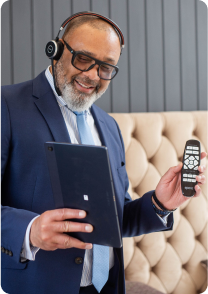Spending long periods of time in bed or having limited mobility can lead to muscles weakening and blood circulation around the body can slow down. For some, the thought of doing exercises or daily movement is daunting. However, hospital beds are a great solution. Having a hospital bed at home offers comfort, safety and versatility making it a valuable tool for those who are bedridden, recovering from injury, have limited mobility or looking to improve their physical heath from the comfort of their own home.
In this article, we’ll explore how a hospital bed can help perform exercises at home as well as how they can positively impact overall health and well-being.
Before we explore further, it’s important to note that exercises in bed may not be suitable for everyone, so it’s always worth checking with a qualified medical professional for advice.
The benefits of exercising
Doing exercise has many benefits both mentally and physically. Exercise helps maintain a range of motion and increase or maintain muscle strength. Both factors can help users retain their independence and quality of life.

Exercising when you have a hospital bed at home is not only important but can also be incredibly beneficial for various reasons:
- Maintaining Muscle Strength: Prolonged periods of immobility can lead to muscle atrophy (muscle weakening). Regular exercises, even while using a hospital bed, can help prevent muscle loss and maintain muscle strength, which is essential for overall mobility and functional independence.
- Improving Circulation: Exercises promote blood circulation throughout the body. Proper circulation helps prevent issues like blood clots, swelling, and pressure sores, which can be common when spending extended periods in bed.
- Joint Flexibility: Gentle exercises can help maintain or improve joint flexibility. Regular movement of joints can prevent stiffness and help you retain a good range of motion.
- Bone Health: Weight-bearing and resistance exercises can help maintain bone density and prevent bone loss, which is especially important for individuals who are bedridden or have limited mobility.
- Enhancing Respiratory Function: Certain breathing exercises can be done while lying down on a hospital bed. These exercises can improve lung capacity and help prevent respiratory complications.
- Mood and Mental Well-being: Engaging in physical activity releases endorphins, which are the "feel-good" hormones. The endorphins can contribute to an improved mood, reduced stress, and enhanced mental well-being.

- Assisting in Rehabilitation: If you're recovering from surgery, long-term illness, or injury, exercises can play a crucial role in your rehabilitation process. They aid in regaining strength, mobility, and functionality.
- Fostering Independence: By maintaining your physical capabilities, you're contributing to your overall independence. Being able to perform daily activities and self-care tasks can enhance your quality of life.
- Preventing Secondary Complications: Regular movement and exercises can help prevent complications like pressure ulcers, urinary tract infections, and constipation, which can arise due to prolonged bed rest.
- Supporting Overall Health: Physical activity is closely linked to overall health. It can help manage chronic conditions, improve cardiovascular health, and contribute to better management of weight and metabolism.
How hospital beds can help with exercises
There are a wide variety of simple exercises to do at home in a hospital bed, with many only requiring the weight of the user’s body and gravity.
Here are some ways hospital beds can support with exercises at home:
- Adjustable positions
Hospital beds have specifically designed features and adjustable positions. For example, you can change the bed’s height, raise and lower the head and foot sections and some models have a full tilt feature.
These adjustments allow you to find the optimal position for different exercises and stretches, ensuring both comfort and effectiveness.
- Safe and Secure
Hospital beds often come with side rails that can provide stability and prevent accidental falls during exercises. This added safety feature is especially helpful if you're working on exercises that require balance or if you're recovering from an injury.

- Range of Motion Exercises
Hospital beds are perfect for performing range of motion exercises, which involve moving your joints through their full range. Whether you're recovering from surgery or trying to improve joint flexibility, the adjustable positions of a hospital bed make it easier to perform these exercises without straining.
- Core Strengthening
You can work on your core muscles right from a hospital bed. By raising the back rest to a sitting position, you can perform exercises like seated leg lifts, pelvic tilts, or seated twists to engage your abdominal muscles and improve core strength.
- Daily Activities
Beyond formal exercises, a hospital bed can assist you in performing daily activities that contribute to your overall well-being. You can use the adjustable positions to make getting in and out of bed easier, supporting your mobility and independence.
- Gentle Stretching
If you or your loved one are aiming for gentle stretches, a hospital bed can provide a comfortable and supportive surface. Adjusting the bed to an incline and having gravity assist you stretches various muscle groups. This is particularly helpful for individuals with limited mobility or those undergoing rehabilitation.
- Resistance Exercises
Hospital beds can also be used for resistance exercises. This can be achieved by attaching resistance bands to the bed's frame or use your body weight against the adjustable sections to create resistance for strength training exercises. This helps you build muscle without needing heavy weights or gym equipment.
- Recovery and Rehabilitation
If you're recovering from surgery, illness, or injury, a hospital bed can aid in your rehabilitation process. You can gradually increase the intensity of your exercises as you heal, with the bed providing the necessary support and safety.
Niall, a recent Opera customer suffered a tragic mountain biking accident which left him paralyzed from the shoulders down. His Opera bed plays a huge part in this recovery and physiotherapy. Learn more about Niall’s story.

Hospital beds for home are a great investment for facilitating care and improving overall health and well-being. At Opera, we have over 20 years expereince in support users and family members find the best solution.
If you’d like us to guide you through the process of making life easier, get in touch with us today.
Exercises at home with a hospital bed
Before starting any exercises at home, it’s important to check with your doctor or physiotherapist – especially if you have a medical condition, disability, or recovering from injury. By doing so, they can guide you on the most appropriate exercises and intensity level based on your individual circumstances and ability.

Here are some simple exercises that can be done from the comfort of a hospital bed:
Palm stretches – these are a great way of building your strength and range of motion in your hands and wrists.
Step 1: Bring your hand up to your body.
Step 2: Keeping your hand flat, extended your fingers..
Step 3: Keep your palm open and then touch your thumb with each finger in turn.
Step 4: Repeat with both hands as many times as you can.
Arm lifts – gets your muscles working, using the weight of each limb and gravity.
Step 1: In a comfortable lying position, bring your arm up – you should be able to feel some resistance.
Step 2: Hold your arm in this position for around 10 seconds, if this is too long reduce the time and gradually increase it each try.
Step 3: If you’re struggling to lift your whole arm, just try it with your lower arm instead and rest your upper arm.
Leg lifts - gets your leg muscles activated.
Step 1: Lying in a comfortable position, lift your leg towards the ceiling
Step 2: Hold your leg in position for 10 seconds, or for as long as it feels comfortable.
Step 3: Gently lower you leg to the bed.
Step 4: Repeat with the other leg.
Hip abduction – helps strengthen the hip area and increase flexibility.
Step 1: Lie with your legs out in front of you.
Step 2: Keeping both of your legs straight and toes pointing to the ceiling, move your leg out to the side.
Step 3: Return to the starting position.
Step 4: Relax and repeat 10 times.
Hip flexion – helps to maintain good posture and core stability.
Step 1: Lying on your back, bend your knee up by sliding your foot up and down.
Step 2: Repeat 10 times.
Summary
A hospital bed at home can significantly aid exercises and physiotherapy by providing a versatile and supportive platform. It enables various adjustable positions, ensuring safe and effective workouts.
Having a hospital bed at home are beneficial for maintaining muscle strength, joint flexibility and even bone health. Meanwhile, they assist in preventing complications from extended bed rest, such as pressure ulcers and circulation issues.
Hospital beds are particularly valuable for post-surgery or injury rehabilitation, aiding in regaining mobility and functionality. Engaging in exercises while using a hospital bed can also enhance respiratory function, boost mood, and promote overall well-being.








